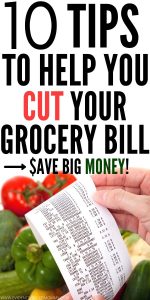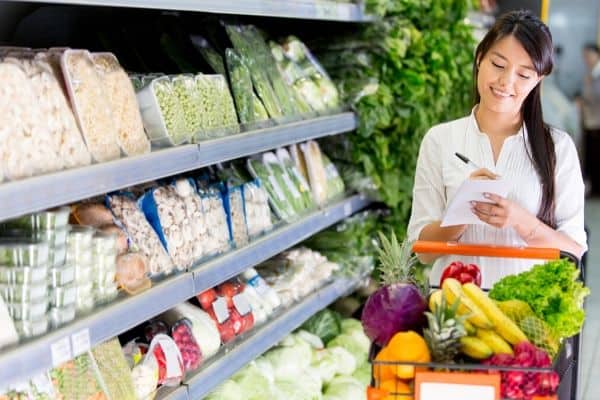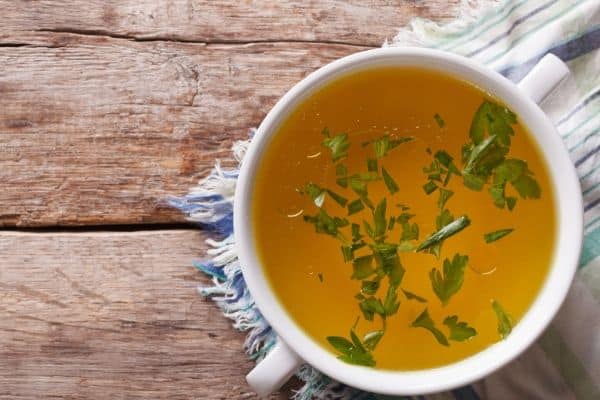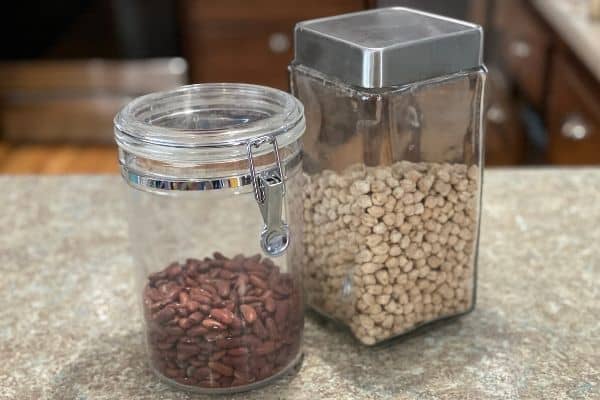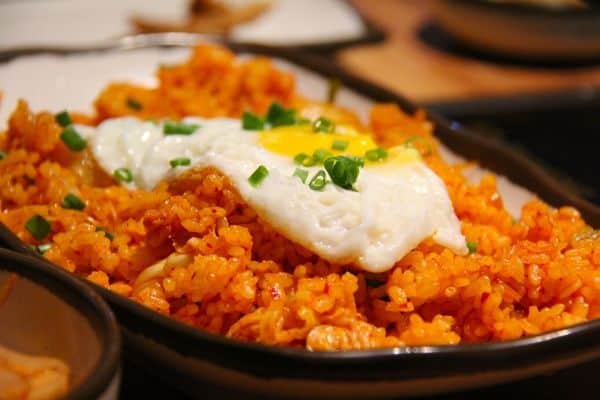We’re all looking for ways to feed our families healthy foods while saving money. But it can be so hard to figure out how to save money at the grocery store on foods you actually need!
Sometimes, it seems like “junk food” is cheaper. That’s where it takes a little savvy to figure out what’s the best healthy food to buy on a budget!
Note: looking for more ways to save money and even get out of debt? Check out this post:
RELATED: How to crush your financial goals this New Year
First, sometimes it’s hard to even know which foods are the most healthy for our families. Marketers are great at making their food sound healthy when it’s really not, so we have to learn how to read labels and figure out what’s really in there before we buy.
Disclosure: This article contains affiliate links. As an Amazon associate I earn from qualifying purchases. You can read my full policy here.
Really, this post has two goals: Teaching us how to decipher tricky food labels and pick the healthiest foods we can, while learning how to score these healthy groceries on the cheap! And don’t worry, I have ideas for both those who eat meat and for vegetarians.
Table of Contents
How do you know which foods are healthy?
That’s the first question: You can’t stretch your dollar at the grocery store for nutritious foods until you know which ones to pick!
Generally, safe bets are whole, minimally-processed foods, like fruits and veggies (fresh or frozen), dried or canned beans, unprocessed meat, and dairy/yogurt. Once you start getting into boxed foods (even ones called “health foods,” things get more hazy.
For example, Quaker has something called “Fiber Protein Instant Oatmeal.” Fiber and protein are good, right?
The problem is, Quaker uses Stevia as a sweetener for this product. While Stevia comes from a plant and is “natural,” it’s not a real sugar, and it may have the same scary side effects as other artificial sugars (like altering gut bacteria or actually causing you to eat more throughout the day). I’m personally just not comfortable with it.
Or Veggie Straws. I’m not saying they’re completely terrible, but don’t let the word “veggie” in the title trick you into thinking they’re healthy. They’re primarily made from potato starch and corn starch, with a little spinach or beetroot powder for coloring. There’s pretty much no vitamins, because they’ve all been stripped out during processing.
The general rule of thumb is to mostly shop the outer perimeter of the grocery store. That’s where you find fresh produce (although frozen is a good choice too), meats, and dairy.
As for center aisles, focus on grains like dried oatmeal, rice, and barley, canned tomato products (tomatoes are one of the few foods that becomes more nutritious from processing), and beans (dried or canned). Avoid highly processed foods.
Bottom line: If you primarily pick “real” foods, you’ll usually be making good choices.
Let’s move on to how to save money at the grocery store!
Use grocery store and coupon apps
Of course, you can always look at sales pages that you get through the mail to plan what to stock up on for the week. But there are more ways than that to save money on groceries!
One really great way to find deals beyond what’s listed at your specific store? The Ibotta app. Basically, you can search it for the items you plan to purchase and add it to a list. Afterwards, you can upload your receipt to the app, and then it’ll send money back to you through PayPal. Pretty sweet!
Best of all, you can get Ibotta for free through this link, and if you use 10 brand name offers within the first 14 days, you’ll get a bonus $20! Try out the Ibotta app here.
Get to the grocery store early
I’ve noticed I’m more likely to find meat or produce on special when I get to the store first thing in the morning. Meats that I like but don’t typically spend the money on (like whole organic chicken or fresh fish) has often been marked down for the morning, but all the deals have been snatched up by mid-day. Yeah, it’s usually something that you should use the same day (that’s why it’s on special!), but if you have the time, this strategy can be really helpful.
Meal plan ahead
With that said, check out what all is on sale (especially with big-ticket items like meat or more expensive produce) before you decide what you’re going to make for the week.
If you know there’s a sale on ground beef, figure out what you want to make with it, buy a bunch, and freeze the rest (I know, common sense, but I also know how easy it is for me to just get whatever I want to make that day instead of planning ahead).
Or if there’s a sale on something that you really prefer to buy organic, like a roasting chicken, grab it when it’s on sale and then make recipes from it all week (more on the awesomeness of whole chicken below).
Another great idea is to make double batches of meals when a key ingredient is on sale. For example, I never just make one lasagna. I make one, and freeze another at the same time. It really doesn’t take any more effort, and that way I’ve saved time and money!
Try frozen veggies
You probably knew that the way veggies are processed affects their nutritional value. Usually, fresh produce is going to be healthiest, but it’s also most expensive.
The best alternative? Frozen fruits and veggies. Frozen vegetables have the nutrients locked in from the freezing process, while canned vegetables actually have lost a lot of vitamins due to processing (plus, they often contain extra salt). Depending on the use you plan for your produce, you may not even notice a difference in taste or texture from using fresh.
Berries have tons of phytonutrients and are great for you. But if it’s not summer, they’re also super expensive. But if you’re using them for yogurt, smoothies, or baked desserts, frozen can be a fantastic alternative. They’ll be lots cheaper, and you’ll still get the great taste and nutrition.
Some of the most nutrient packed produce you can buy? Leafy greens, like spinach and kale, are especially important to our diet. In fact, with the folate, magnesium, iron, and choline in it, spinach is absolutely one of the best foods for women’s health. If you want to go cheaper and longer-lasting on these two greens, frozen is the way to go. While frozen greens don’t work for every purpose, they’re great for soups or casseroles.
Buy in-season produce
But other times, you want to use fresh produce.
There are several affordable, nutrient-dense veggies out there, like cabbage (try sautéing it!), broccoli, carrots, and winter squash. Sweet potatoes are also a win. And Russet potatoes, despite their bad rap, are nutritious too, especially when the peel is eaten. The trick is to prepare them in a healthful way (instead of drowning them in high-fat dairy).
Onions and garlic are both cheap, nutritious vegetables that add a lot of flavor to your food. Both of these foods have anti-inflammatory properties that protect your heart health and boost your immune system. Your kids might be picky about onions (I know mine are), but just keep adding them and eventually they’ll either pick them out or give up and start eating them.
And of course, you have to have leafy greens for nights that you have salad. But be aware of the nutrient content of different greens! Not everyone is up for baby spinach or kale in their salad, and that’s okay. If you switch your iceberg lettuce for romaine, you’ll get a lot of vitamins A and K.
And some of those favorite fruits or veggies, like berries or winter squash, are much cheaper in season. So enjoy all the fresh blueberries and strawberries in the summer, and then switch to frozen for the rest of the year.
Don’t let food go to waste – Make broth/stock!
This isn’t about guilting you in to not wasting food, it’s more about finding ways to be creative! You’d be amazed how much you can get out of common products if you use them right.
Not only will you save money on bullion, homemade broth and stock is SO much better than store bought. Plus, it’s really simple to make (especially with an Instant Pot).
I’ve got tips for making stock and broth from chicken, veggies, and more! Check them out on this post!
RELATED: Easy, healthy stocks and broths for soups and more
Freeze leftovers when you get bored of a meal
No shame, it happens. Sometimes you make a giant meal, eat on it for a few days, and then you’re just over it. Many pastas, soups, chilis, or casseroles can be frozen as-is. If you have a pot roast or leftover chicken or turkey, shred or cube it and then freeze it. If the pot roast has leftover juices from cooking, strain it and freeze it for beef broth. You can move on from that meal, but be ready for another day.
Plan more vegetable-focused meals
If you came from a family that had meat at pretty much every meal, this can be hard. But once you find a few favorites, you might find that there’s some vegetarian meals you like better than some of your meat-based meals!
Even when you do eat meat, you can definitely make things cheaper just by thinking about preparation techniques. For example, foods like hamburgers, where every person gets a quarter of a pound of beef, can get pricey. But when you use that same ground beef to make spaghetti sauce or chili, the protein is stretched and you save a lot of money (not to mention you get more veggies and more vitamins and minerals!).
With that said, you have to make sure you still get plenty of protein with your meals, regardless of meat content. Fortunately, that’s pretty easy to do.
Stock up on beans
You can’t beat beans for a nutritious, cheap protein source. Beans are a great source of protein, fiber, and several necessary vitamins and minerals. If you choose to cook them from dried, you can literally feed your family on just a few dollars.
Traditionally, beans need a long soak and several hours to cook, but again, the Instant Pot can save you tons of time! You can cook pinto beans in around an hour, and black-eyed peas in even less time. Nothing short of a miracle.
Even if you choose to use canned beans, they’re still a really economical source of protein. And it’s so easy to make cheap, healthy, and quick meals with them! In fact, several of my favorite recipes from the corners of the internet are based on canned beans, including this pasta and white beans with rosemary garlic oil from Smitten Kitchen.
#putaneggonit
If you’re not vegan, eggs are another great source of protein and lots of vitamins and minerals (make sure you eat the yolk to get all the nutrition!). While we usually just think of using eggs in recipes or scrambled for breakfast, they’re actually really versatile.
You can put together a fantastic start to your morning with sautéed greens, a slice of whole-grain toast, and an egg your way.
Many soups, rice bowls, salads, and other simple meals can be improved with the addition of a poached or fried egg. You can even top casseroles with baked eggs! However you choose to #putaneggonit, you can know that you’re providing your family with a cheap and healthy protein source.
Conclusions on saving money on healthy food at the grocery store
Even though it seems difficult, it’s actually pretty easy to save money on healthy groceries once you know how! I hope you enjoyed learning how to save money while feeding your family healthy meals.
Any questions about nutrition and specific foods? Let me know in the comments!

